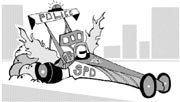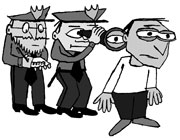LAST FRIDAY, a jury determined Seattle police officer Craig Hansen was not at fault when he struck and killed bicyclist Joel Silvesan. Although the jury heard nearly two weeks of testimony, the outcome was preordained.
It has been decades and well over 100 such cases since any inquest in King County found any officer to be at fault in any civilian’s death. Inquests are public, fact-finding procedures that are called by the King County executive when any civilian dies at the hands of local law enforcement officers. Unfortunately, inquests do very little to either exonerate or incriminate an officer in these incidents, because the inquest structure doesn’t lend itself well to clearly establishing what happened and why. But even within those limitations, the inquest into Joel Silvesan’s death revealed some important things.
The morning of Feb. 27, 2001 was clear, dry, and cold; at 6 a.m. it was still dark. Officer Hansen was racing, as backup, to assist in a traffic stop. Silvesan was riding down North 90th Street near Aurora Avenue. The question, for Silvesan, was: Did he try to cross the intersection on his bike when the light was red or green? For Hansen: Was he speeding unnecessarily? Was he using his warning signals?
After the inquest, despite the jury’s findings, we still don’t know. A witness claimed, in the media, both that Hansen had run the red light without warning signals and that he had “gunned his engine” going through the intersection. However, on the stand, the witness turned out to not even be remotely credible. Another witness thought Hansen had the green, but that the officer had not been using his lights or siren. Police witnesses believed Hansen had the green light, but were mixed regarding his use of signals. The jury believed Hansen had the green light but did not have on all his warning signals.
Meanwhile, subpoenaed witnesses were not located; the judge did not allow Silvesan’s family’s lawyer to call a number of his own witnesses or pursue important lines of questioning. These sorts of limitations to the inquest process make it hard for police to be held accountable even when the evidence of wrongdoing seems clear. That was not the case here, but family members still felt the process was unfair and stacked against them.
SILVESAN’S INQUEST, however, raises another, larger issue. By all accounts, officer Hansen is a decent young man genuinely devastated by the accident. But it was a preventable accident, and one the Seattle Police Department shows no interest in trying to prevent from being repeated.
Beyond the traffic lights and warning signals, it also developed at Silvesan’s inquest that the police dispatcher had, just before the accident, radioed that it was no longer necessary for Hansen to speed to the traffic stop, meaning that he could slow down to the 35 mph speed limit. Hansen did not slow down. Moreover, police testified at the inquest that officers have the option of ignoring dispatch signals to slow down and, in fact, regularly keep speeding on the logic that it’s always vital to get to a scene as soon as possible because, well, you never know. The jury found that Hansen was traveling 45-55 mph when he struck and killed Silvesan.
When officers commonly drive like this—speeding unnecessarily, going through intersections without slowing to look, possibly (in this case) ignoring traffic signals, or not using warning lights—the odds will catch up, and accidents like Silvesan’s tragedy happen. Seattle’s fire trucks and ambulances slow down at intersections, and ambulances have a time-related life-and-death urgency far more frequently than patrol cars do. To many people, the fact that SPD, alone among emergency services, often flaunts traffic laws for no apparent reason reflects a mentality that SPD feels it is above the law. That’s a community relations problem that is even more severe now than it was last February.
How could this be fixed? Cameras in patrol cars would help. But I’d be happiest with Silvesan’s death leading to a determination by every single SPD patrol officer to drive by the rules of the road unless it’s a genuine emergency. It would improve the level of respect given officers in the community, but more importantly, it would save lives.







